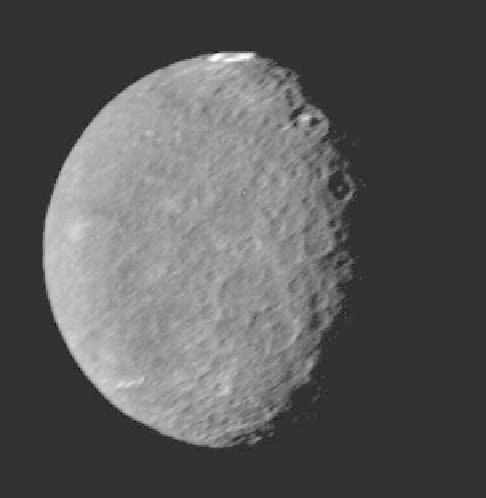Geology Reference
In-Depth Information
Figure 10.8. The 1,170 km in diameter Umbriel is very dark,
suggesting the presence of non-ice materials on the surface.
Although it is heavily cratered, the relative absence of bright ejecta
rays suggests some process of surface darkening. The prominent
crater toward the top of the image on the terminator has a bright
central peak; the bright ring near the equator also could be the
remnant of an impact (NASA Voyager 2 PIA00040).
Figure 10.9. A composite of two Voyager images for Titania, the
largest moon of Uranus at 1,578 km in diameter, showing abundant
impact craters and tectonic deformation of the ice-rich crust (NASA
Voyager PIA00039).
The chasmata and the smaller grabens indicate tectonic
extension and are the youngest features seen on the 40%
of the surface imaged by Voyager 2.
Oberon is the second largest moon of Uranus and is the
most heavily cratered (
Fig. 10.10
). Like Titania, it is
thought to be composed of nearly equal amounts of
water-ice and rocky materials and might also have liquid
water at the interface with the rocky interior. It, too, is in
synchronous rotation with Uranus, but it is not completely
immersed in the magnetosphere. Thus, unlike Titania,
Oberon
'
is trailing hemisphere is not darkened but instead
is slighter brighter. Moreover, the leading hemisphere
surface tends to be somewhat red, which is probably due
to implantation of material derived from uranian irregular
(i.e., captured) satellites, as suggested by Bonnie Buratti
of the Jet Propulsion Laboratory and Joel Mosher (Buratti
and Mosher,
1991
). Crater Hamlet is the largest con
rmed
impact seen in Voyager images at 206 km in diameter.
However, NASA scientist Jeff Moore and colleagues
(Moore et al.,
2004
) have suggested that a topographic
feature seen on Oberon
'
s limb could be the central peak of
an even larger impact structure. Many of the numerous
impact craters have bright rays of fresh ice and the floors
Wokolo in the southern hemisphere. Many of the craters
have central peaks, some of which are rather bright, which
could indicate exposures of fresh ice. The most prominent
feature is a bright ring within crater Wunda, which is
131 km in diameter.
Titania is the largest of the uranian satellites (
Fig. 10.9
).
It is thought to be differentiated, and its high density
(1.71 g/cm
3
) suggests about equal amounts of water-ice/
water and rocky material; Titania might even have liquid
water at the interface with the rocky interior if ammonia or
salts are present to lower the melting temperature of the ice.
As with the other uranian moons, Titania is in synchronous
rotation and its trailing hemisphere is in
uenced by the
plasma of the magnetosphere, causing preferential darken-
ing. The surface shows abundant impact craters as large as
326 km (crater Gertrude), many of which have central
peaks. Some of the impact craters are relatively shallow,
which is thought to result from relaxation of the ice.
Relatively smooth plains are present, re
ecting one or
more episodes of resurfacing (possibly from cryovolcan-
ism). Tectonism is represented by huge canyon systems,
including Messina Chasma, which is nearly 1,500 km long.




